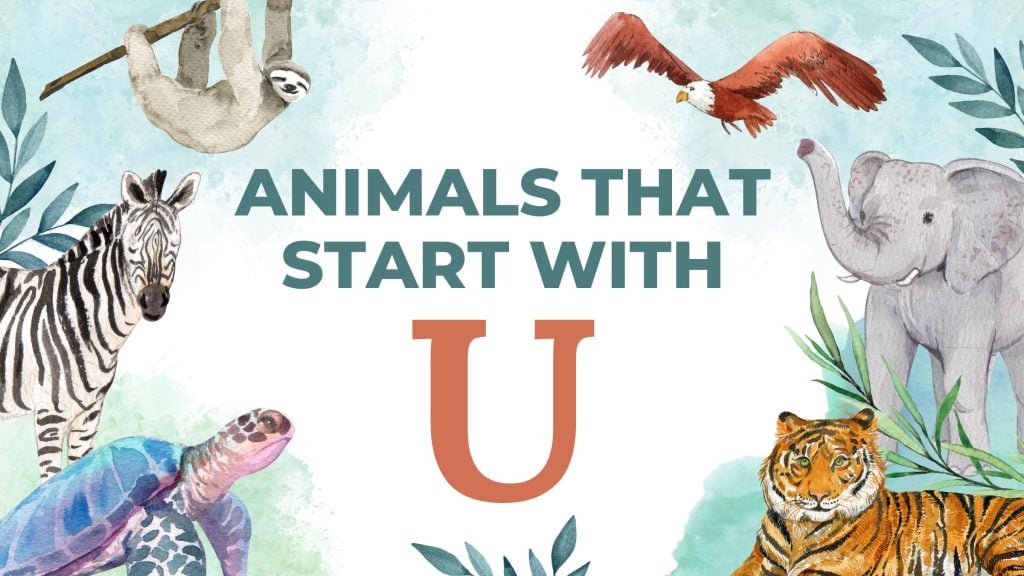
The letter U might not be one of the most common letters of the alphabet, but there are still plenty of animal species that start with it. This includes everything from tiny birds and rodents to massive creatures like giraffes and bears.
If you love learning about new animals, then U is the perfect letter to explore. It includes some of the most unique critters imaginable.
List of Animals
Here are 42 animal species that start with the letter U.
Click an animal name to jump to its full description, image, and more below.
| Animal | Type | Region |
|---|---|---|
| Uaru Cichlid | Fish | South America |
| Ugandan Giraffe | Mammal | East Africa |
| Ugandan Kob | Mammal | Central Africa |
| Ugandan Red Colobus | Mammal | East Africa |
| Uguisu | Bird | East Asia |
| Uinta Chipmunk | Mammal | Western United States |
| Uinta Ground Squirrel | Mammal | Western United States |
| Ultramarine Flycatcher | Bird | South Asia |
| Ultramarine Grosbeak | Bird | South America |
| Uluguru Forest Tree Frog | Amphibian | East Africa |
| Ulysses Butterfly | Insect | Australasia |
| Umbrella Cichlid | Fish | South America |
| Umbrella Cockatoo | Bird | Southeast Asia |
| Umbrella Slug | Mollusk | Indo-Pacific, Atlantic Ocean |
| Unau | Mammal | South America |
| Undulate Ray | Fish | Eastern Atlantic, Mediterranean |
| Undulated Moray | Fish | Indo-Pacific |
| Undulated Tinamou | Bird | South America |
| Unicolored Antwren | Bird | South America |
| Unicorn Caterpillar Moth | Insect | North America |
| Unicorn Leatherjacket | Fish | Worldwide (Subtropical Oceans) |
| Uniform Antshrike | Bird | South America |
| Uniform Finch | Bird | South America |
| Unstriped Ground Squirrel | Mammal | East Africa |
| Upcher’s Warbler | Bird | Southwest Asia, East Africa |
| Upland Buzzard | Bird | Central Asia |
| Upland Chorus Frog | Amphibian | Eastern United States |
| Upland Goose | Bird | South America |
| Upland Pipit | Bird | South Asia |
| Upland Sandpiper | Bird | Americas |
| Upside-Down Catfish | Fish | Central Africa |
| Ural Field Mouse | Mammal | Europe, Asia |
| Ural Owl | Bird | Europe, Asia |
| Urial | Mammal | Central Asia |
| Ursula’s Sunbird | Bird | West-Central Africa |
| Urutu Snake | Reptile | South America |
| Ussuri Brown Bear | Mammal | East Asia |
| Ussuri Dhole | Mammal | Central and South Asia |
| Uta Hick’s Bearded Saki | Mammal | South America |
| Utah Mountain Kingsnake | Reptile | Western United States |
| Utah Prairie Dog | Mammal | Western United States |
| Utila Spiny-Tailed Iguana | Reptile | Central America |
1. Uaru Cichlid
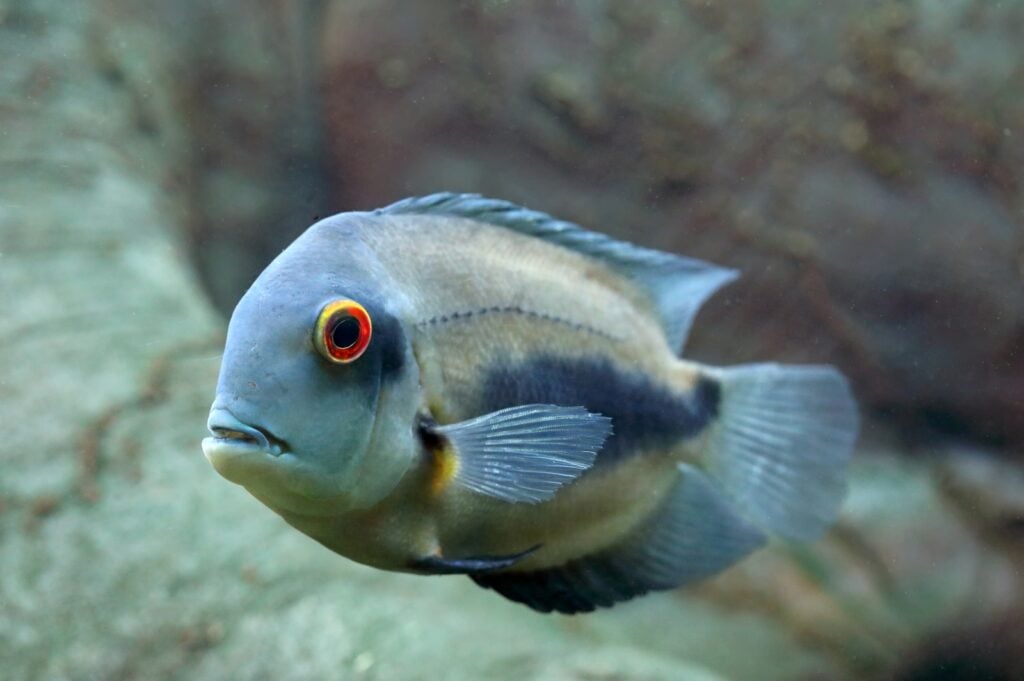
- Scientific Name: Uaru amphiacanthoides
- Habitat: Amazon River basins of South America
- Size: Up to 10 inches
- Diet: Algae, aquatic plants, other vegetation
While many cichlids are considered aggressive, this is one of the most peaceful cichlid species. Male and female Uaru cichlids are almost identical, with females being only slightly smaller and rounder. These fish change colors slightly throughout the year, with their light gray bodies becoming darker and their yellow eyes becoming red just before the spawning season. They’re thought to be intelligent fish that are capable of recognizing the person feeding them.
2. Ugandan Giraffe
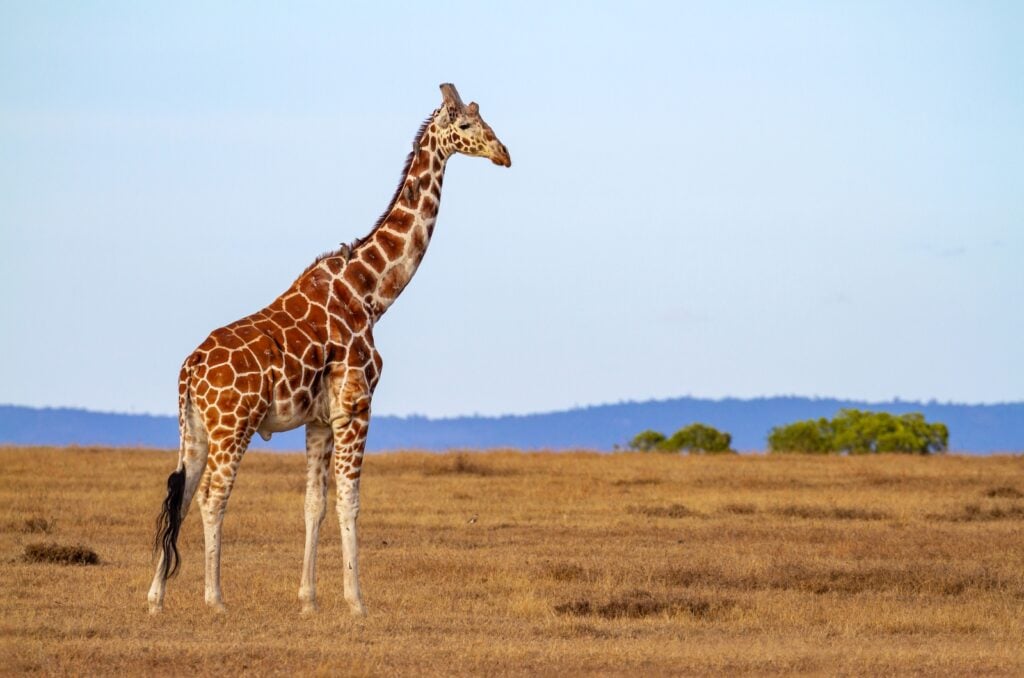
- Scientific Name: Giraffa camelopardalis camelopardalis
- Habitat: Savannas and woodlands of Ethiopia, Kenya, Uganda, South Sudan, and Sudan
- Size: Up to 20 feet tall
- Diet: Leaves, stems, twigs, flowers, fruits
The Ugandan giraffe, also called the Nubian giraffe and Rothschild’s giraffe, is a subspecies of giraffe with defined chestnut-colored spots. Sadly, these beautiful creatures are critically endangered, with their population dropping by 95% in the past 30 years. They typically travel in groups of only males or only females. To establish dominance, male Ugandan giraffes fight with their necks, which helps them determine who will mate with a female.
3. Ugandan Kob
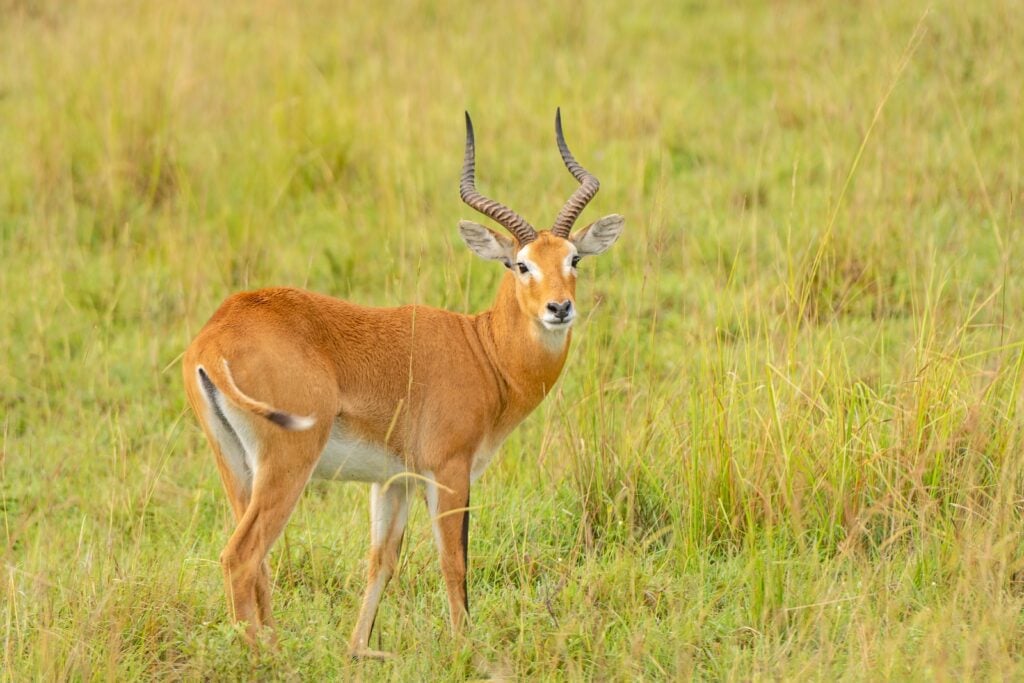
- Scientific Name: Kobus kob thomasi
- Habitat: Grasslands, floodplains, and savannas of South Sudan, Uganda, and the Democratic Republic of the Congo
- Size: 139 to 207 pounds
- Diet: Grasses, reeds
Ugandan kobs don’t have a specific breeding season. Instead, they breed year-round with one offspring at a time and an 8-month gestation period. Male Ugandan kobs make whistling sounds to announce their territory. When threatened, these mammals leap high in the air and retreat to the water to escape predators. They always stay near water, so they rarely wander deep into arid regions.
4. Ugandan Red Colobus
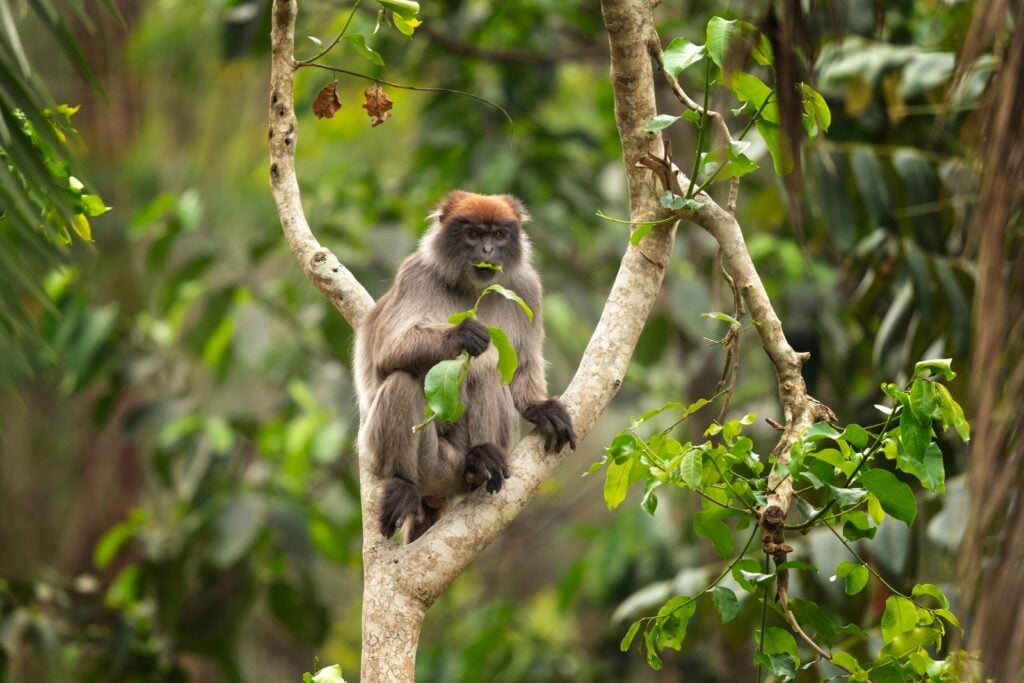
- Scientific Name: Piliocolobus tephrosceles
- Habitat: Jungles of Uganda and Tanzania
- Size: 15 to 23 pounds
- Diet: Leaves
Despite being called the Ugandan red colobus, these primates are not very red. Their fur is mostly gray with a rusty red patch on top of their heads. They live in groups that can be as small as three or as large as 85. There are usually several males in each group, but the females typically outnumber the males. They may break into smaller groups to forage, where they feed solely on leaves with a preference for young leaves.
5. Uguisu
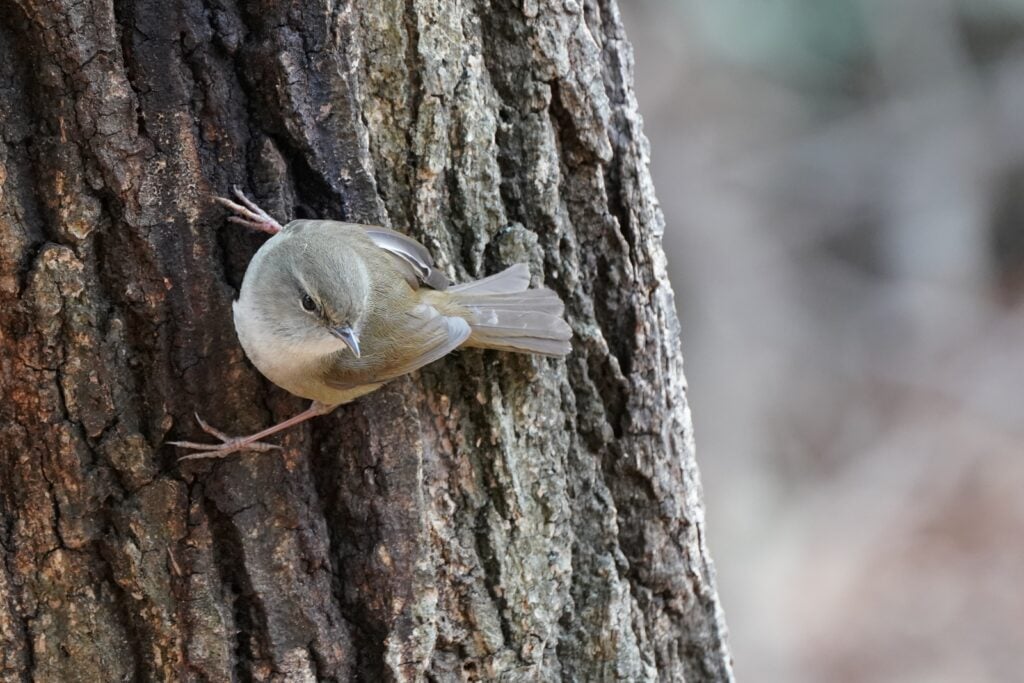
- Scientific Name: Horornis diphone
- Habitat: Forests and bamboo thickets in Japan and the northern Philippines
- Size: 5.5 to 6 inches
- Diet: Insects, insect larvae, worms, spiders
Known worldwide as the Japanese bush warbler, this bird is called Uguisu in Japanese. When the birds sing, it almost sounds like they’re saying the name Uguisu. Their feathers are typically a mix of olive green and brown, allowing them to easily hide among dense vegetation. While it’s not part of their native range, these birds now live in Hawaii because they were brought there in 1929 to control pests.
6. Uinta Chipmunk
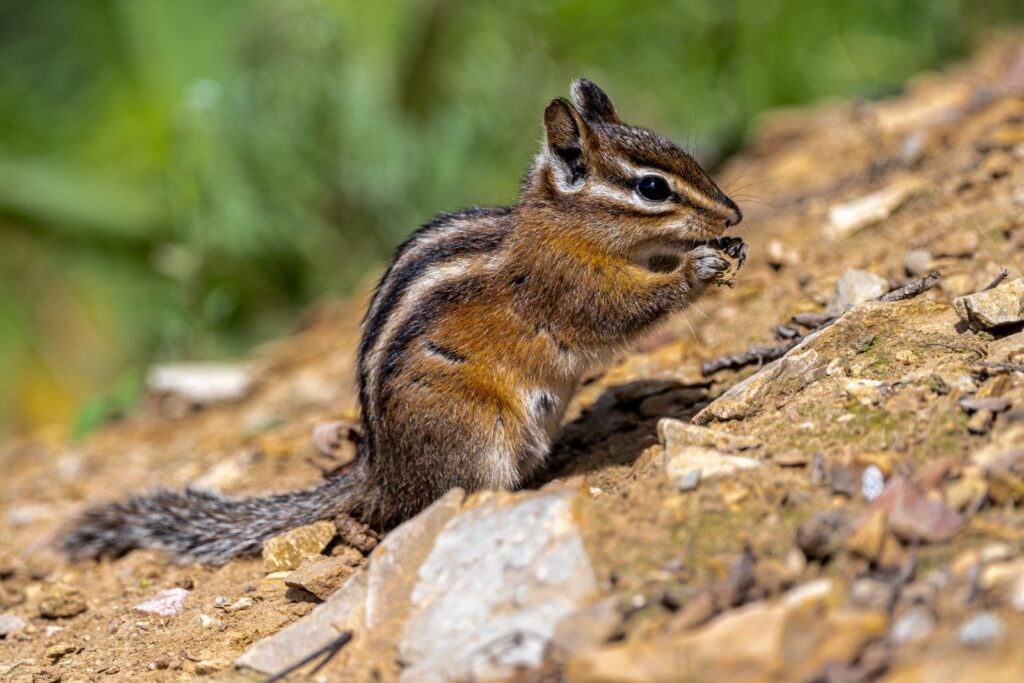
- Scientific Name: Neotamias umbrinus
- Habitat: Forests and shrublands of the western United States
- Size: 7.9 to 9.4 inches
- Diet: Seeds, fruits, fungi, shoots, leaves
These adorable little rodents are actually highly territorial. They spend most of their time alone and defend 2 to 5 hectares from other chipmunks. They use a wide variety of sounds, including “chips,” “chucks,” squeals, and trills, to communicate with each other. Like other rodents, they start storing food in the fall and then go into hibernation or torpor during the coldest part of the year.
7. Uinta Ground Squirrel
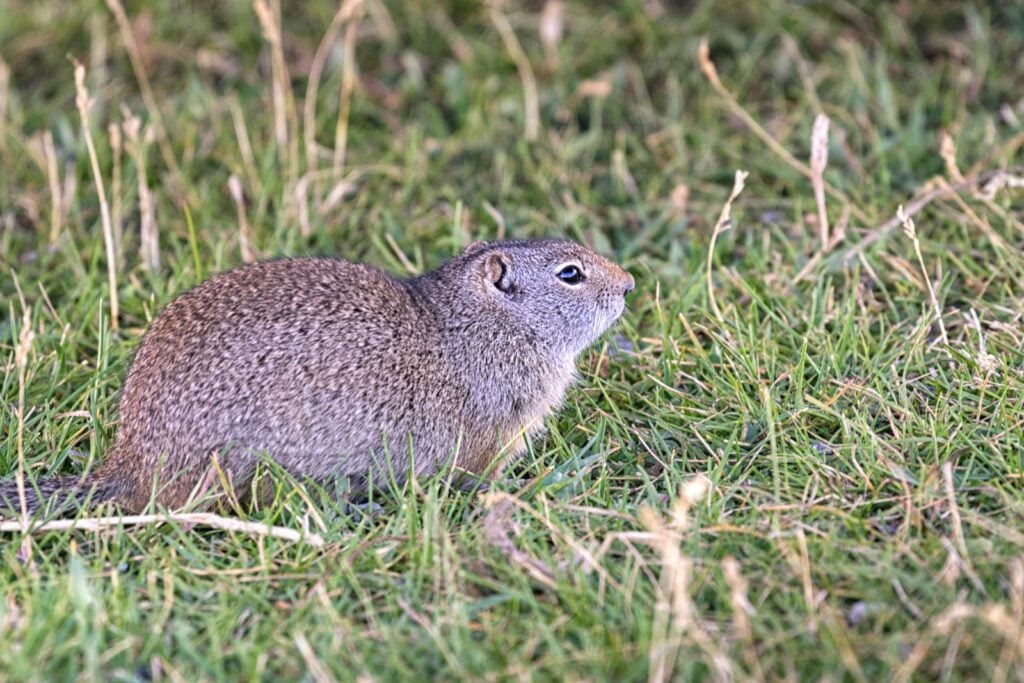
- Scientific Name: Urocitellus armatus
- Habitat: Grasslands and meadows of the western United States
- Size: 11 to 12 inches
- Diet: Grasses, forbs, mushrooms, insects, carrion
Uinta ground squirrels typically live in colonies, acting aggressively toward rodents outside of their group. The males have scent glands in their cheeks, which they rub on the ground to mark their territory. When threatened, they may bristle their fur to appear bigger. They will resort to wrestling or chasing if an unfamiliar ground squirrel refuses to leave their territory. As winter approaches, they eat a little more food each day to bulk up for hibernation.
8. Ultramarine Flycatcher
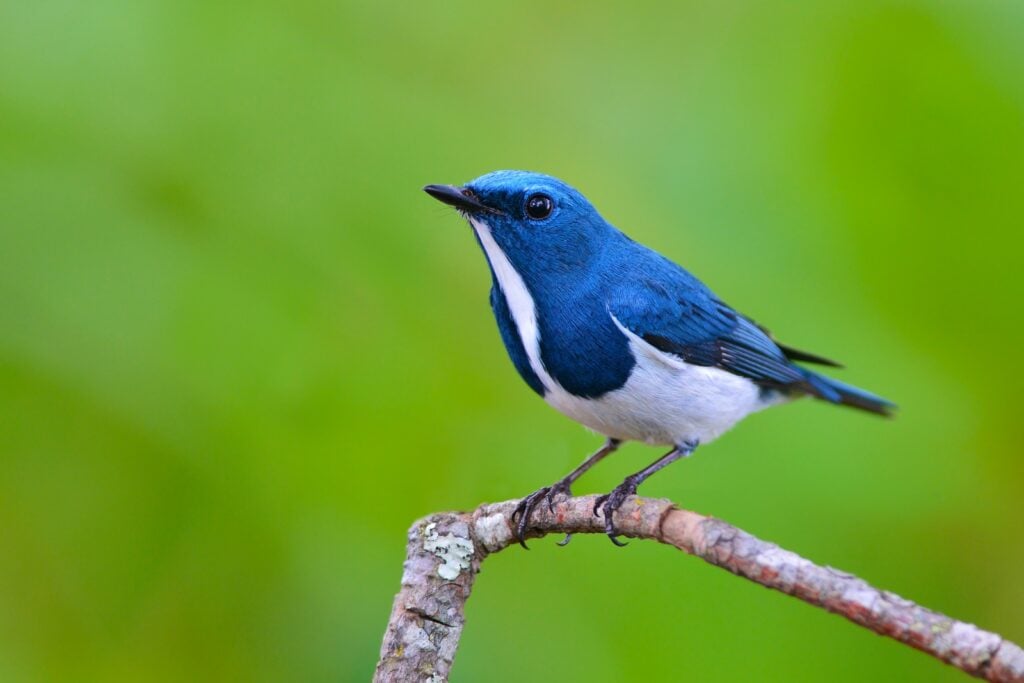
- Scientific Name: Ficedula superciliaris
- Habitat: Montane forests of southern Asia
- Size: 4.3 to 4.7 inches
- Diet: Insects
Females of this species are a dull gray-brown color, while males have vibrant ultramarine feathers with a white belly. Males that live further west have white “eyebrows” while eastern ultramarine flycatchers don’t. In the summer, you’ll find these birds in the Himalayas to breed, but as winter approaches, they fly south to warmer areas. Their eggs are a beautiful olive green hue with reddish-brown freckles.
9. Ultramarine Grosbeak
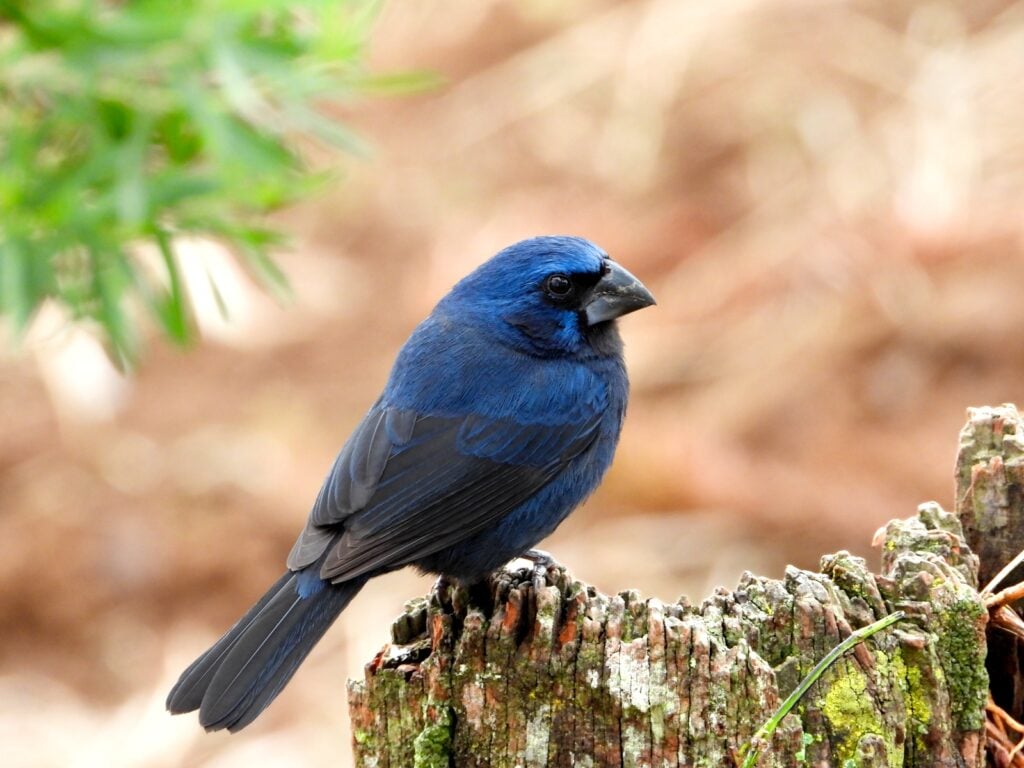
- Scientific Name: Cyanocompsa brissonii
- Habitat: Wooded habitats near water of central and eastern South America
- Size: About 6 inches
- Diet: Seeds, fruits, insects
Male ultramarine grosbeaks are a bold blue hue with hints of black and dark gray, but females are a solid reddish-brown instead. These birds are typically found solo or in pairs. Like other grosbeaks, they have dense bills to help them crack through the hard shells of seeds. While almost all ultramarine grosbeaks live in central and eastern South America, there are a few small populations on the north end of the continent.
10. Uluguru Forest Tree Frog

- Scientific Name: Leptopelis uluguruensis
- Habitat: Subtropical and tropical moist forests of Tanzania
- Size: 1.2 to 1.7 inches
- Diet: Insects
The most notable feature of the Uluguru forest tree frog, also known as the ruby-eyed tree frog, is the animal’s massive eyes. Their large, dark eyes make them look like cartoon characters, but those eyes help enhance their vision in dimly lit areas. This can help them locate prey and avoid predators even in rainforests with little light. These frogs are usually blue-green, but some also have hints of yellow and brown.
11. Ulysses Butterfly
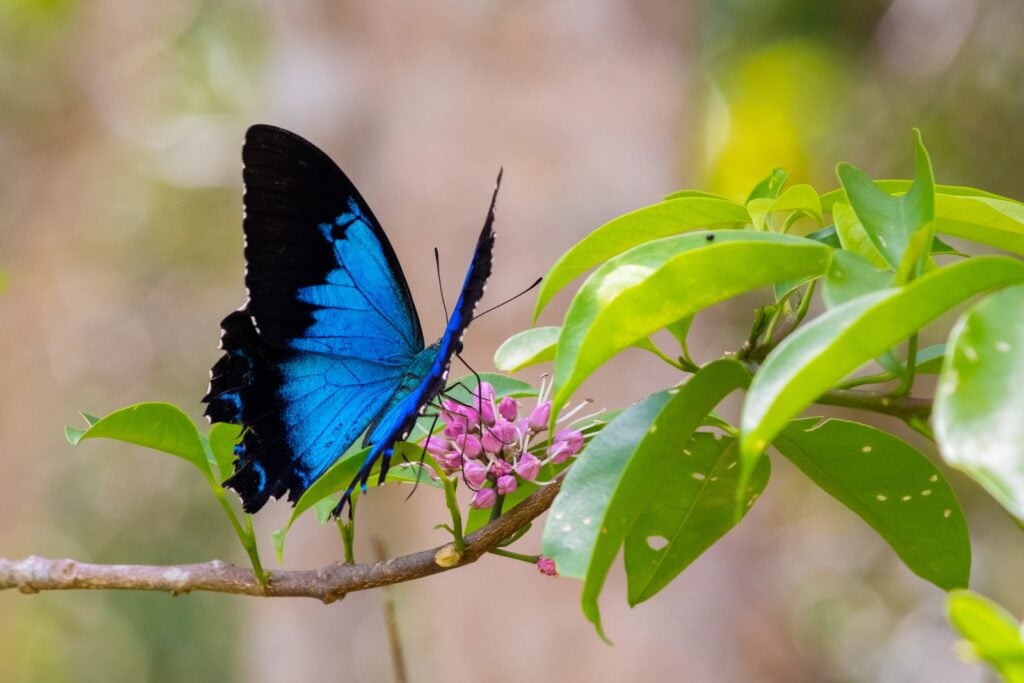
- Scientific Name: Papilio ulysses
- Habitat: Tropical rainforests of Australia, Indonesia, Papua New Guinea, and the Solomon Islands
- Size: Wingspan of 4.1 to 5.5 inches
- Diet: Nectar
The Ulysses butterfly, also known as the blue mountain swallowtail butterfly, has electric blue wings that stand out from the green plants around it. The caterpillars of this species look very different with a green and white pattern. Adult males are attracted to other blue animals and objects, so they sometimes mistake blue items like flowers for potential mates. These butterflies are important pollinators, spreading pollen between flowers as they eat nectar.
12. Umbrella Cichlid
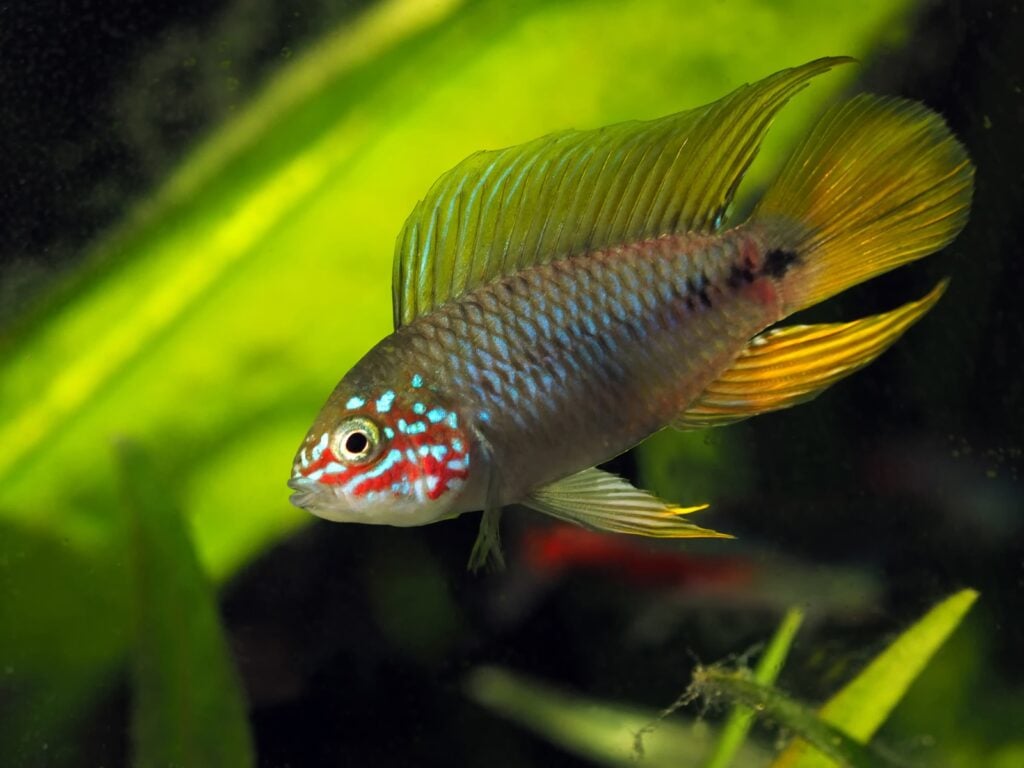
- Scientific Name: Apistogramma borellii
- Habitat: The Paraguay River and Paraná River of South America
- Size: 2 to 3 inches
- Diet: Small invertebrates
Umbrella cichlids, also called yellow dwarf cichlids, have large dorsal fins that slightly resemble umbrellas. Males are larger and more vibrant with extended dorsal fins. In the wild, these fish breed during the rainy season since that’s when food is most abundant. They mate and lay eggs in caves, but once the female lays the eggs, she makes the male leave the cave. Even after the eggs hatch, the female guards the young fish closely as they grow.
13. Umbrella Cockatoo
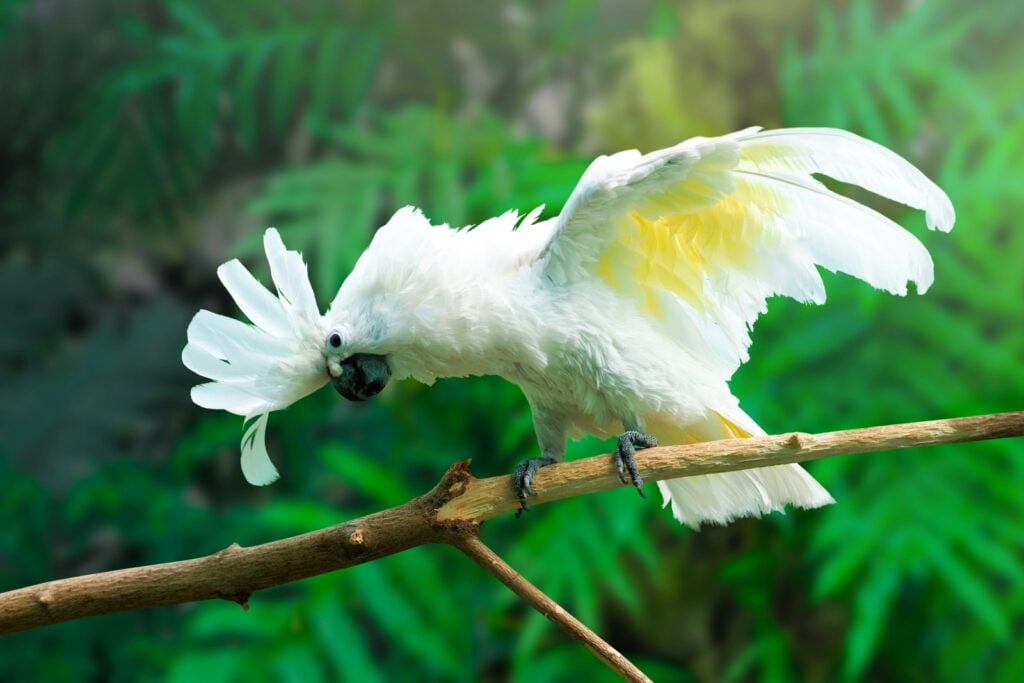
- Scientific Name: Cacatua alba
- Habitat: Tropical forests of the North Malaku islands in Indonesia
- Size: 18 to 24 inches
- Diet: Seeds, nuts, fruits, roots
White cockatoos are also called umbrella cockatoos because of the large crest of feathers on their heads. They raise their feathers as a form of communication, which could indicate feelings like excitement, curiosity, fear, or aggression. These birds have zygodactyl feet, which means they have two toes facing forward and backward to make it easy for them to grab objects and climb. They’re noisy birds that can learn to mimic about 20 to 30 human words and phrases.
14. Umbrella Slug
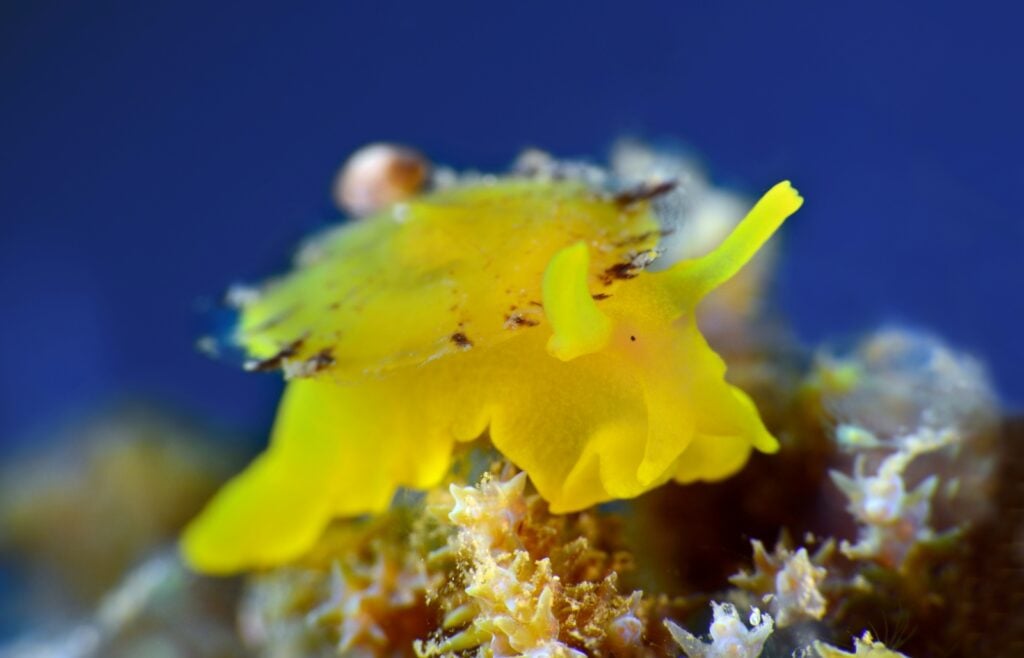
- Scientific Name: Umbraculum umbraculum
- Habitat: Tropical and warm temperate waters of the Indo-Pacific and Atlantic Oceans
- Size: Up to 8 inches
- Diet: Sponges, bivalves
These unique sea slugs have a back that’s much wider than the rest of their body, making it look like they have an umbrella. They can vary in color, including browns, yellows, reds, and blues. Their unique colors help them blend into their surroundings, causing them to look like coral and aquatic plants. This can protect them from predators while also making it easy for them to hide while searching for prey.
15. Unau
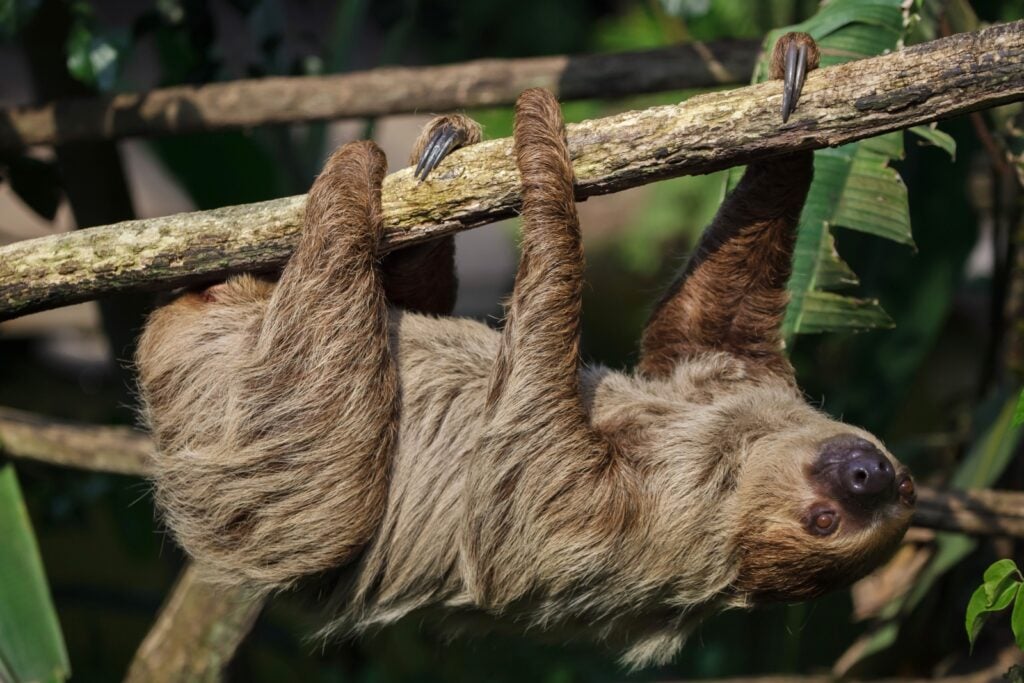
- Scientific Name: Choloepus didactylus
- Habitat: Tropical rainforests of northern South America
- Size: 20 to 26 inches
- Diet: Leaves, fruits, buds
Unau is a nickname for the Linnaeus’s two-toed sloth. It’s the Tupí word for lazy, referencing the sloth’s slow-moving behaviors. Like other sloths, they move like that because their metabolisms are very slow. To make up for it, they eat about half as many calories as similarly sized mammals. These sloths primarily stay in the trees because they don’t move well on the ground. However, they’re great swimmers, allowing them to escape predators if they have access to water.
16. Undulate Ray

- Scientific Name: Raja undulata
- Habitat: Sandy bottoms of coastal waters of the eastern Atlantic Ocean and western Mediterranean Sea
- Size: 2 to 3.3 feet
- Diet: Crustaceans, squid, small fish
Undulate rays stay in sandy or muddy areas so they can bury themselves as a form of camouflage. Even though they’re called rays, they’re technically skates instead. Skates don’t have venomous spines like most rays. These skates lay eggs made of keratin, which is the same material that our hair and nails are made of. When these eggs hatch, the empty egg cases are called “mermaid purses” by people who find them on the shore.
17. Undulated Moray

- Scientific Name: Gymnothorax undulatus
- Habitat: Reefs of the Indo-Pacific and east-central Pacific Oceans
- Size: 2 to 5 feet long
- Diet: Small fish, crustaceans, cephalopods
Undulated morays have several rows of teeth, including one that runs through the center of the roof of the mouth. These sharp teeth are designed for tearing flesh instead of grinding prey. Undulated morays spend most of their time hiding in crevices, only coming out at night to hunt. They swim low to the bottom and are more likely to swim away from threats than strike. They continuously open and close their mouths to help with water flow through their gills.
18. Undulated Tinamou

- Scientific Name: Crypturellus undulatus
- Habitat: Humid forests of northern and eastern South America
- Size: 11 to 12 inches
- Diet: Fruits, seeds, insects
Tinamou can fly if needed, but they aren’t the strongest fliers, so they spend most of their time on the ground. They’re shy creatures that blend in well with dirt and branches, so they can be difficult to spot. They live in a variety of forest habitats, but they prefer to stay near rivers when possible. They make loud, repeated “whoo” sounds, which are most common during early mornings and late afternoons.
19. Unicolored Antwren
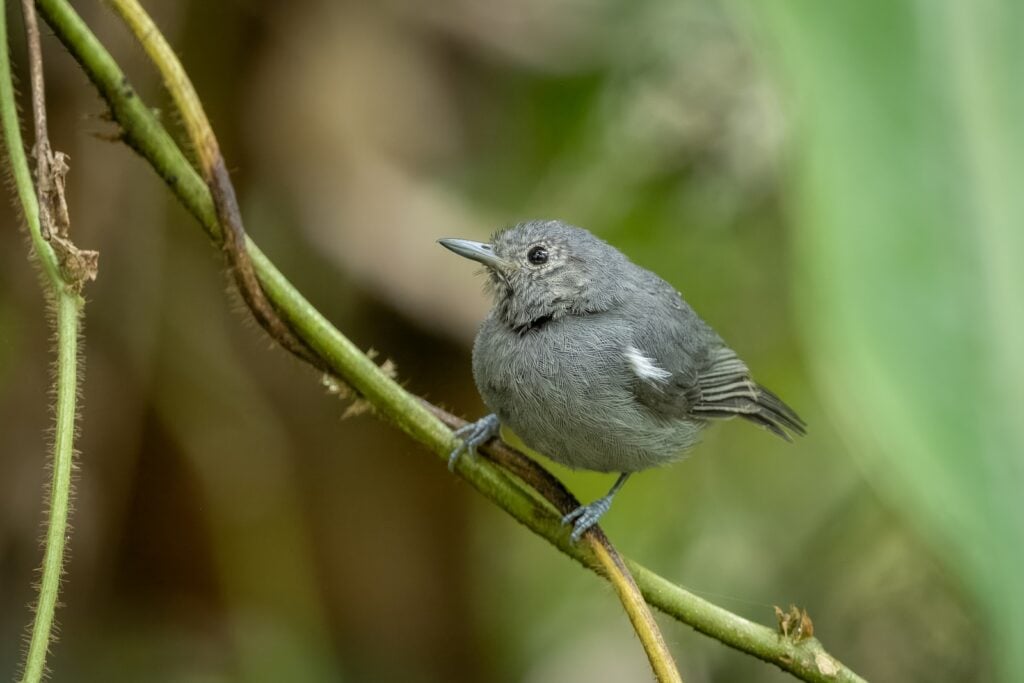
- Scientific Name: Myrmotherula unicolor
- Habitat: Forests of southeastern Brazil
- Size: 3.5 to 3.9 inches
- Diet: Insects, spiders
These tiny, short-tailed birds stick to the lower and middle levels of humid Brazilian forests. They prefer areas with dense vegetation since they can hide better while also having access to lots of invertebrates. The males are a solid gray color, while the females are solid gray-brown. They’ve been spotted alone, in pairs, or part of mixed-species flocks with other small birds.
20. Unicorn Caterpillar Moth
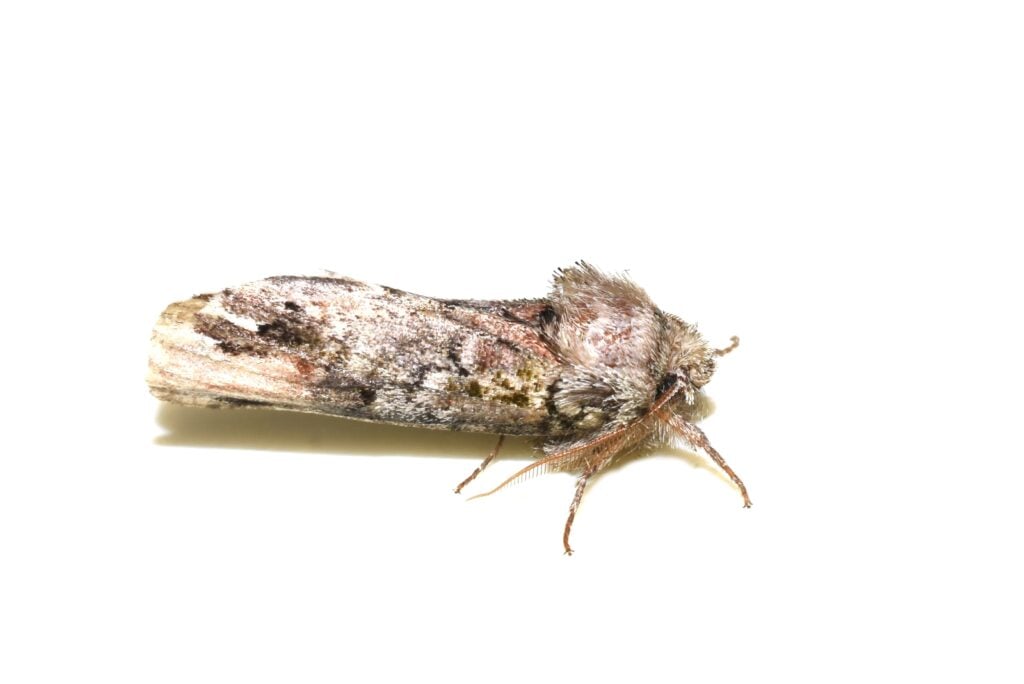
- Scientific Name: Coelodasys unicornis
- Habitat: Woodlands in North America (south of the Arctic)
- Size: Wingspan of 1 to 1.4 inches
- Diet: Nectar, honeydew, sap, decaying fruit
The caterpillars of this species have a long horn near their heads that can spray predators with acid as a form of defense. That prominent horn disappears when the caterpillar grows into a moth. The caterpillar bodies have a mix of green and brown, making them blend in well with branches and leaves. They eat a variety of leaves as caterpillars, but as moths, they have a siphon-like mouth that only allows them to consume liquids.
21. Unicorn Leatherjacket
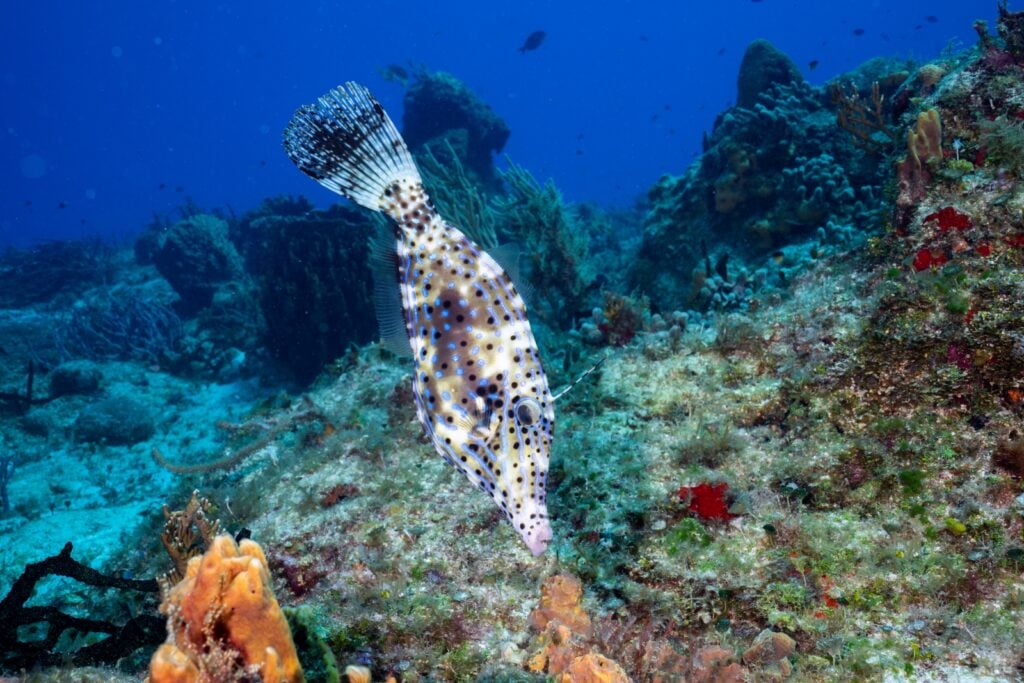
- Scientific Name: Aluterus monoceros
- Habitat: Subtropical oceans worldwide
- Size: Up to 30 inches
- Diet: Plankton, other invertebrates, plant matter
These filefish have a “horn” of varying sizes, with some appearing like a long car antenna. They have a very narrow body that’s usually gray or brown with spots. Little is known about this unique species, but they usually appear in shallow areas near steep drop-offs. They gather most of their prey from sandy ocean floors.
22. Uniform Antshrike
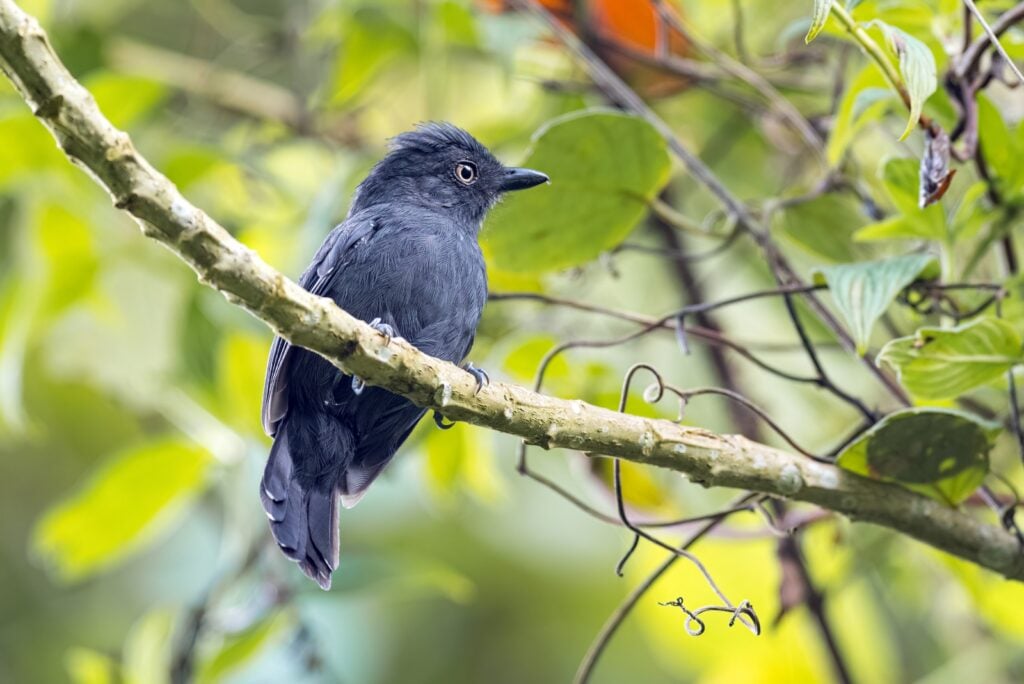
- Scientific Name: Thamnophilus unicolor
- Habitat: Tropical and subtropical forests of the Andes in Colombia, Ecuador, and Peru
- Size: 5.7 to 6.7 inches
- Diet: Insects, other arthropods, seeds
Male uniform antshrikes are solid gray, while females are solid brown with a gray face. They have short bills with a hooked tip to help them catch insects. They stay in the understory of forests in the Andes, where they mostly remain among dense vegetation rather than coming out in the open. While they typically appear alone or in pairs, they’ve been observed in mixed-species flocks occasionally.
23. Uniform Finch
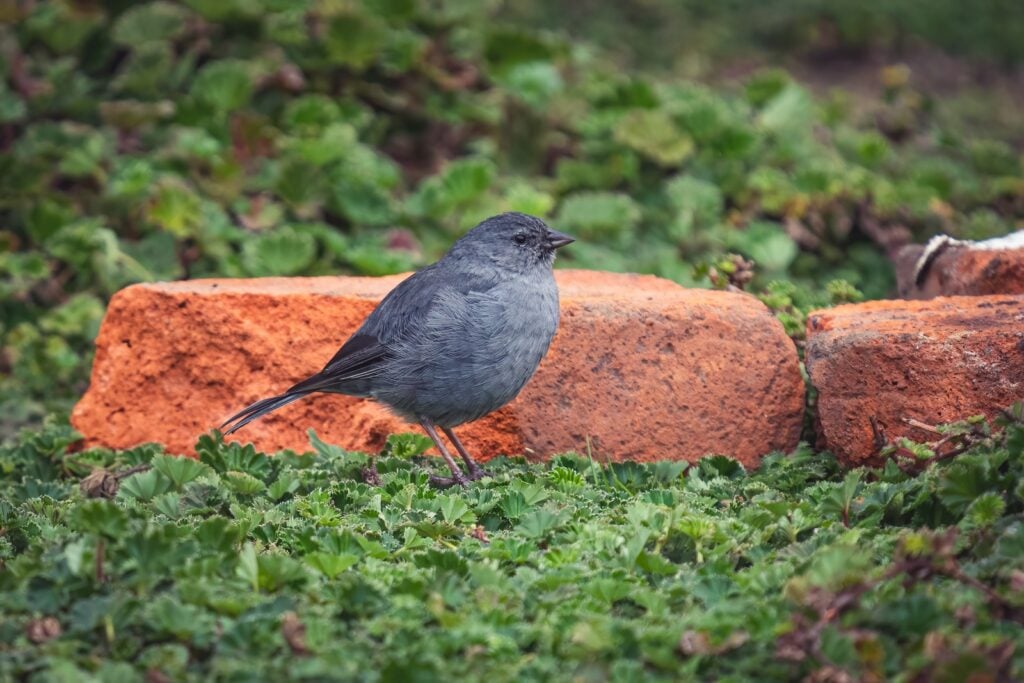
- Scientific Name: Haplospiza unicolor
- Habitat: Tropical and subtropical forests in the southern Atlantic Forest
- Size: About 5 inches
- Diet: Seeds, fruits, insects
Similar to uniform antshrikes, uniform finches are solid gray as males and light brown as females. They’re often found on the ground of forests as they forage for seeds and other food items. Their conical bills are perfect for breaking through the seeds they find. These birds make buzzy, high-pitched calls to communicate with each other.
24. Unstriped Ground Squirrel
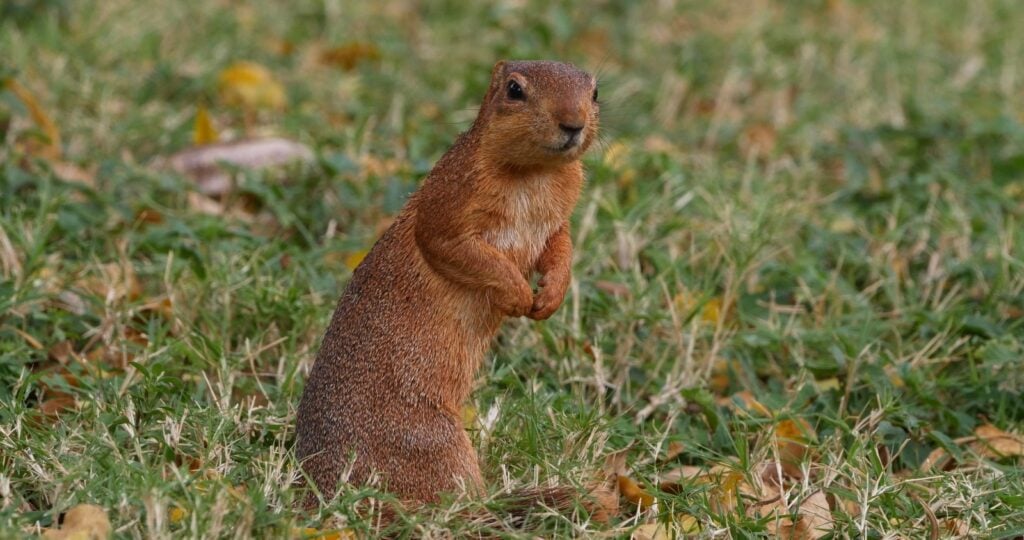
- Scientific Name: Xerus rutilus
- Habitat: Savannas and scrublands of eastern Africa
- Size: 7.9 to 10 inches
- Diet: Leaves, tree fruits, seeds, grasses
Most ground squirrels have stripes running along their backs, but the unstriped ground squirrel stays true to its name by only having solid brown fur. While they can climb to locate food, they also dig burrows where they can rest and hide. They sometimes share their burrow system with another unstriped ground squirrel. These rodents aren’t affected by poisonous tannins, so they can eat some toxic fruits when other foods are scarce.
25. Upcher’s Warbler
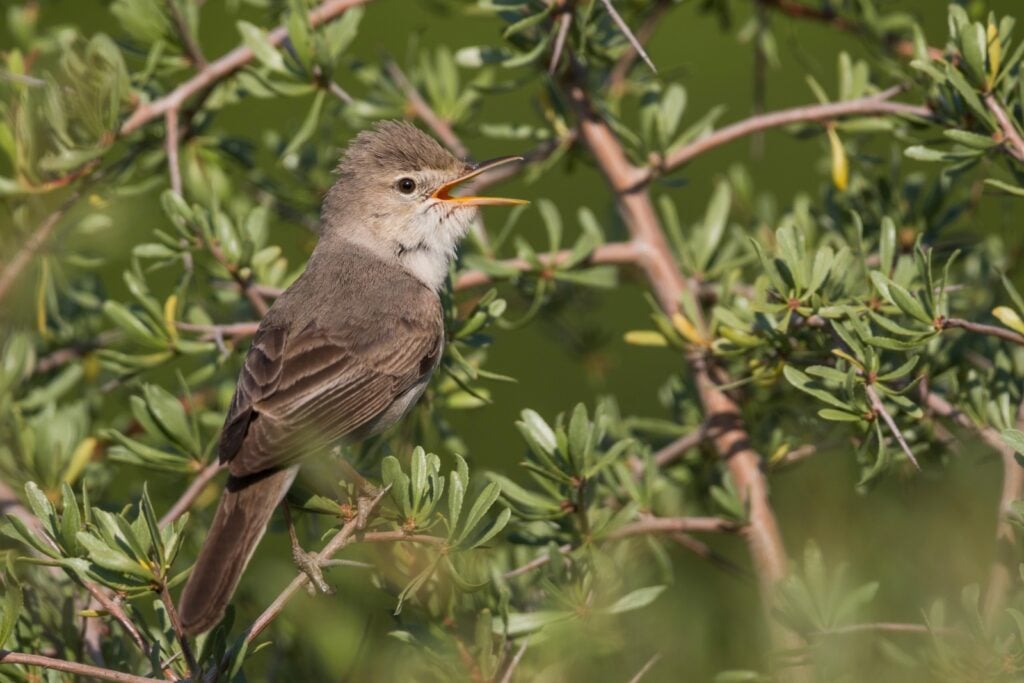
- Scientific Name: Hippolais languida
- Habitat: Semi-desert habitats of southwestern Asia and eastern Africa
- Size: 5.5 to 5.9 inches
- Diet: Insects, other small invertebrates
Like other warblers, Upcher’s warblers are known for being noisy. They sit on high perches and sing repetitive songs that sound both musical and scratchy. These songs help them attract mates and defend territories. They frequently move their tails while perched. They primarily build their nests in bushes and low trees, laying four to five eggs per clutch.
26. Upland Buzzard

- Scientific Name: Buteo hemilasius
- Habitat: Open mountainous areas across central Asia
- Size: 4 to 5 foot wingspan
- Diet: Small mammals, birds, eggs, insects
Upland buzzards are most commonly seen hovering since they swoop down in mid-flight to catch prey rather than perching. Voles are one of the most common prey animals of upland buzzards, and researchers have found that this bird’s breeding success varies based on how many voles are nearby. These buzzards normally stick to areas with elevations of 3,300 to 14,800 feet, but they’ve been found as high as 16,000 feet.
27. Upland Chorus Frog
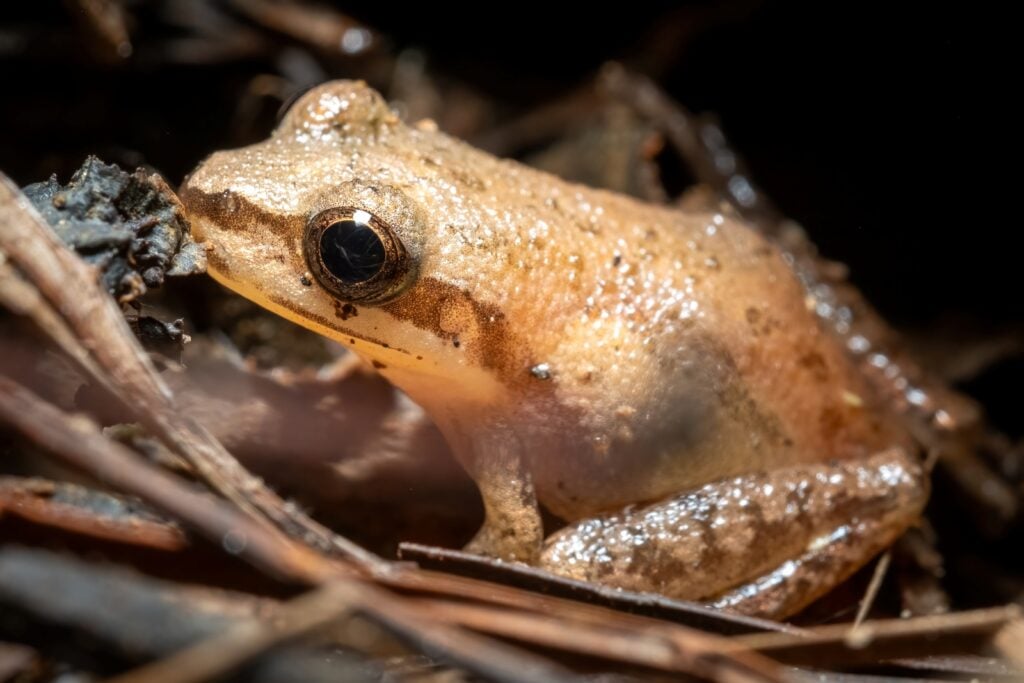
- Scientific Name: Pseudacris feriarum
- Habitat: Moist, grassy areas across parts of the eastern United States
- Size: 0.75 to 1.5 inches
- Diet: Insects, spiders, other small invertebrates
The upland chorus frog makes a repeated “creek” call, which can be compared to the sound of a person running their finger over the teeth of a comb. They’re typically only heard after it rains, and they’re rarely seen since they’re most active at night. They stay close to a permanent water source, which is where they lay their eggs. These frogs breed during cool, rainy periods, and one female can lay up to 1,000 eggs at a time.
28. Upland Goose
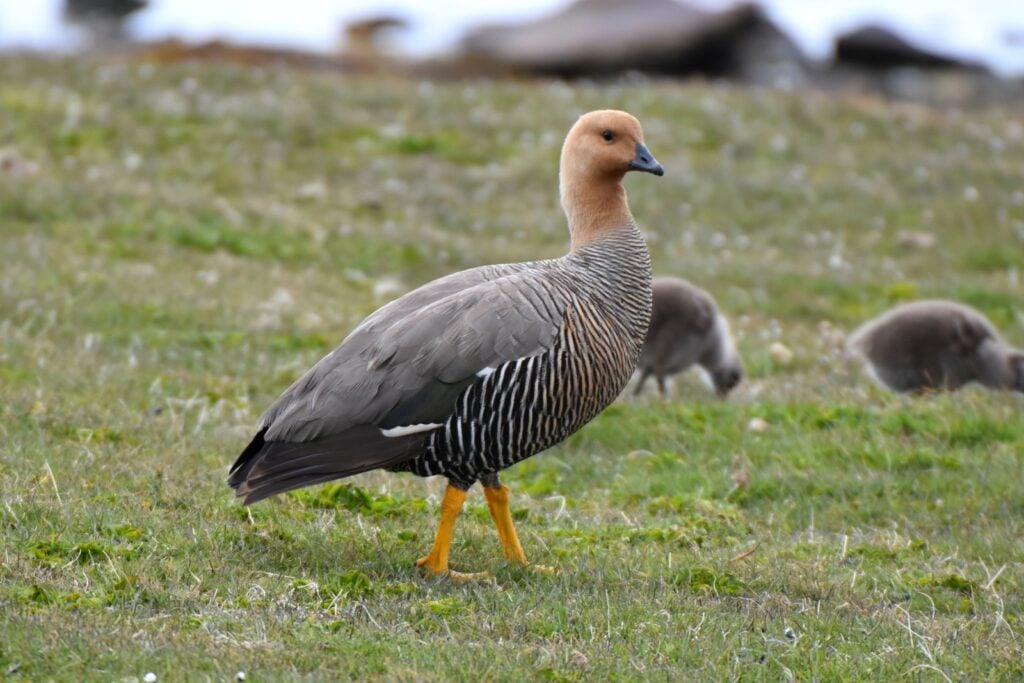
- Scientific Name: Chloephaga picta
- Habitat: Open grassy areas of southern South America
- Size: 24 to 29 inches
- Diet: Seeds, grasses, leaves, stems, other plant matter
Most of the time, upland geese stay near short grass for grazing, but they prefer long grass for nesting because it hides their eggs well. They’re social birds that sometimes flock in thousands. Farmers consider these geese pests because their large flocks will sometimes feed on pastures. These geese return to the same area to breed almost every year. The chicks only stay in the nest for one day after hatching, quickly learning to feed themselves.
29. Upland Pipit
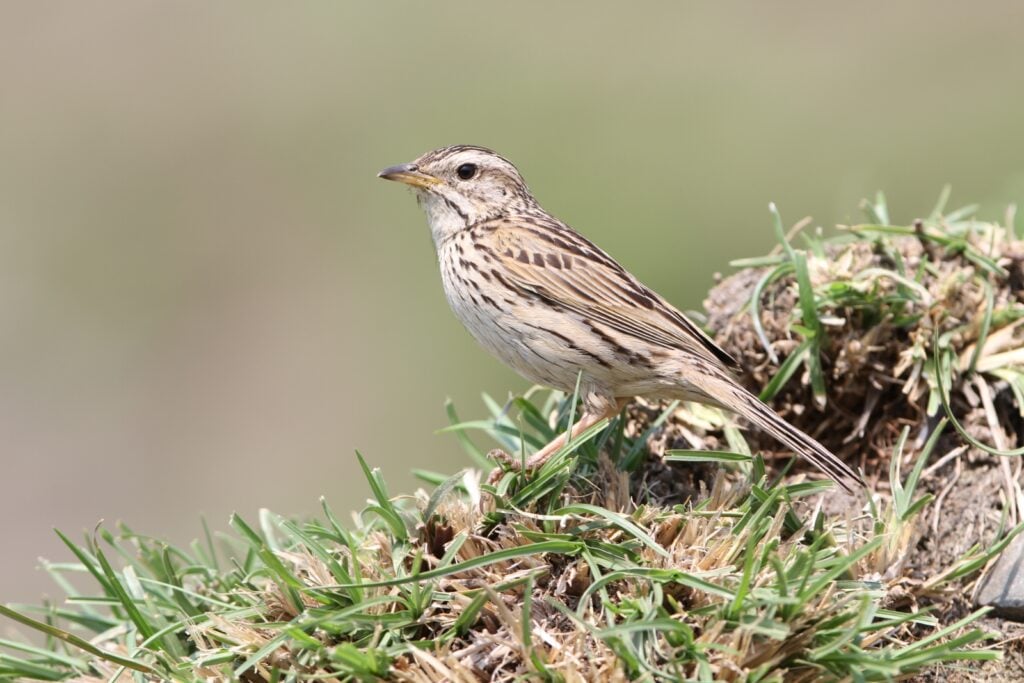
- Scientific Name: Anthus sylvanus
- Habitat: Grasslands and rocky areas of Afghanistan, China, Hong Kong, India, Nepal, and Pakistan
- Size: About 6.7 inches
- Diet: Insects, seeds, plant matter
These small birds spend most of their time foraging for insects and seeds alone or in loose flocks. They primarily feed on the ground, but they’re agile fliers, so they can also catch insects in mid-flight if the opportunity presents itself. They make repetitive whistles to attract mates or make their territory known. They’ve been observed showing aggression toward other birds and even large mammals entering their territories.
30. Upland Sandpiper
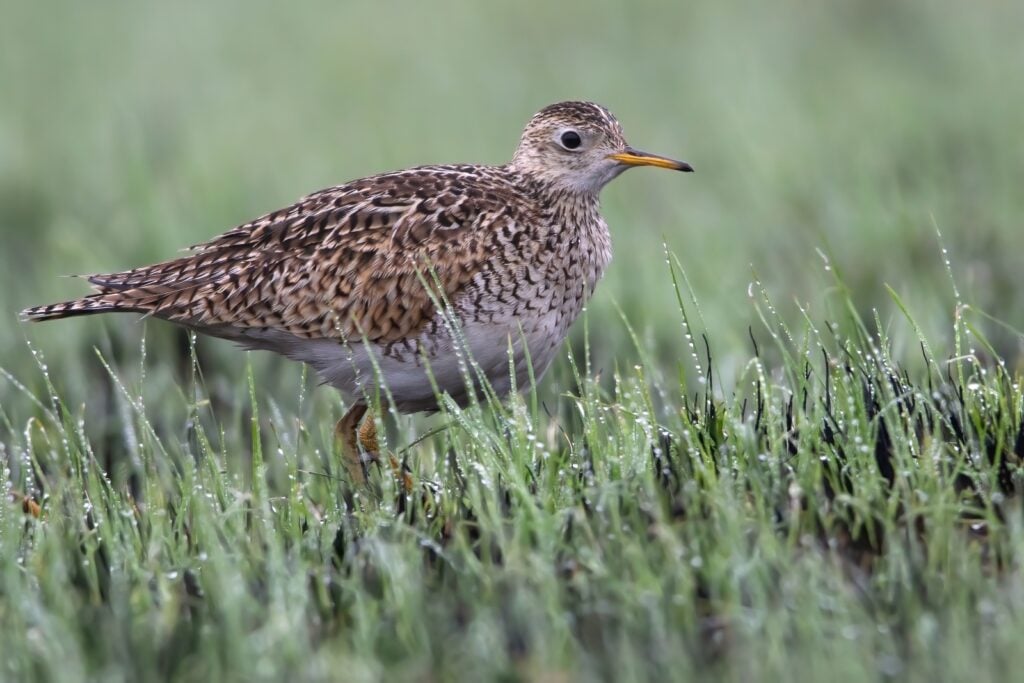
- Scientific Name: Bartramia longicauda
- Habitat: Open grasslands and meadows from parts of Canada to central South America
- Size: 11 to 13 inches
- Diet: Insects, worms, other invertebrates
Despite being called sandpipers, upland sandpipers forage in grassy areas rather than at beaches. They create loud wolf whistle sounds that make their presence known to those around them. They typically move quickly by running for a short distance, stopping, and then running again. When they’re born, these sandpipers are top-heavy and clumsy until about a week later, when they learn to find their own food.
31. Upside-Down Catfish
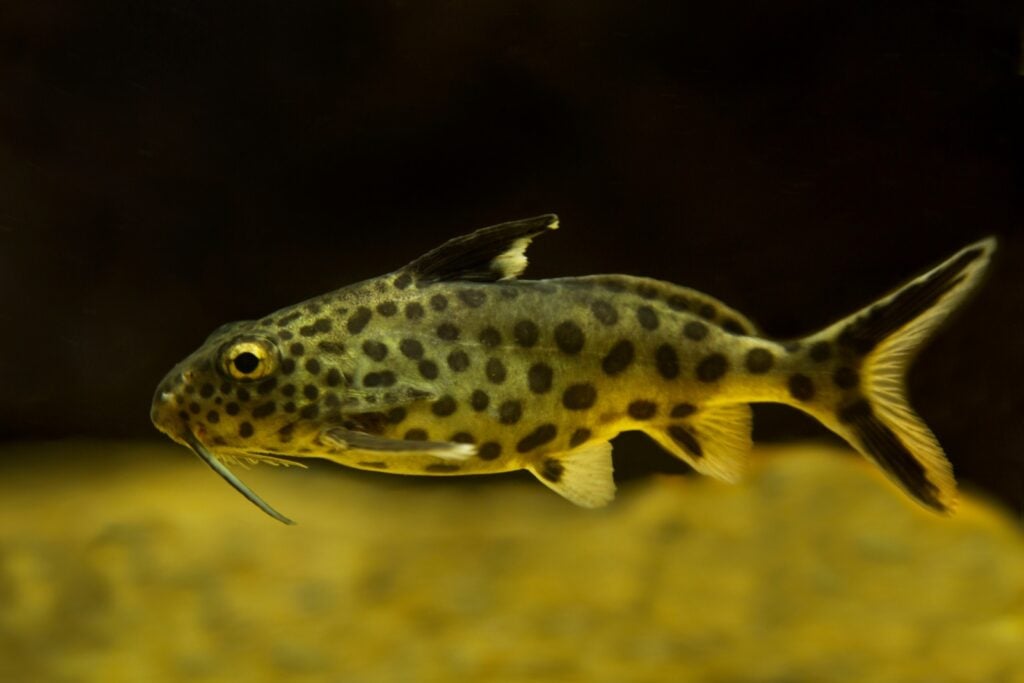
- Scientific Name: Synodontis nigriventris
- Habitat: Slow-moving rivers and streams of the Congo Basin
- Size: 3 to 4 inches
- Diet: Insects, insect larvae, algae
These fish earned the name upside-down catfish because they frequently swim upside down. This bizarre behavior is a feeding strategy, giving them quick access to insects that fall on the water’s surface. While swimming upside down often indicates an illness, such as a swim bladder issue, for other fish, it’s perfectly normal for these catfish. Males and females of this species have similar coloring, but females are typically larger and more bloated.
32. Ural Field Mouse
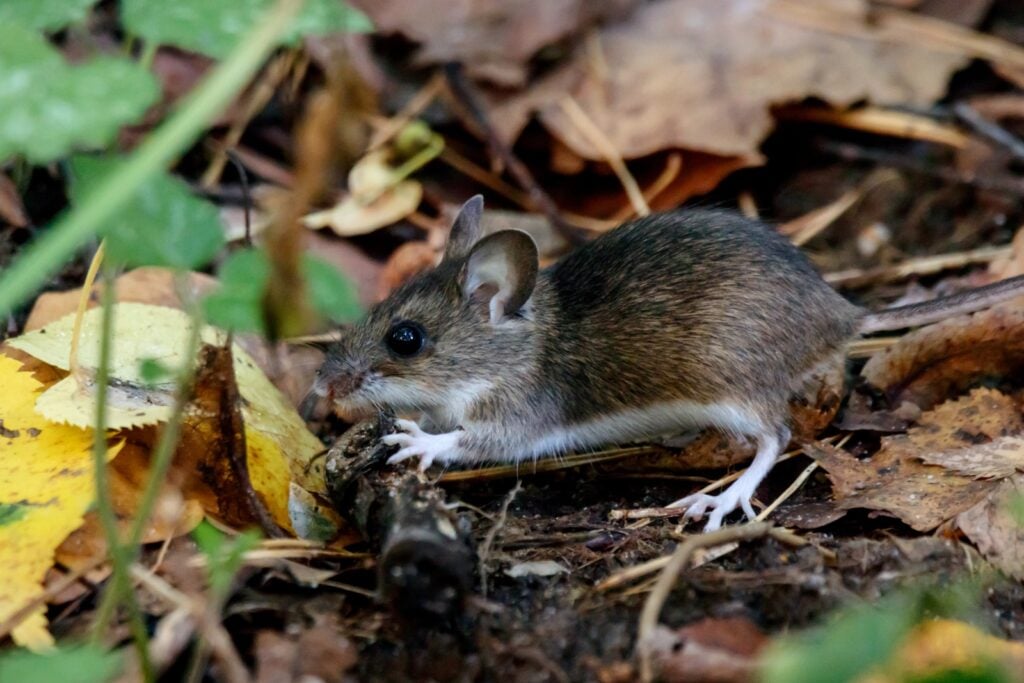
- Scientific Name: Apodemus uralensis
- Habitat: Forests, meadows, and fields across areas of Europe and Asia
- Size: 2.8 to 4.2 inches
- Diet: Seeds, fruits, insects
Ural field mice, also known as pygmy field mice, are tiny mice that live across various habitats in Europe and Asia. Since they crawl among tall grass and leaf litter, they’re often difficult to spot. Like other field mice, they don’t have the best eyesight, but their hearing and sense of smell are strong. They’re fast for their size, running up to six miles per hour to escape predators.
33. Ural Owl
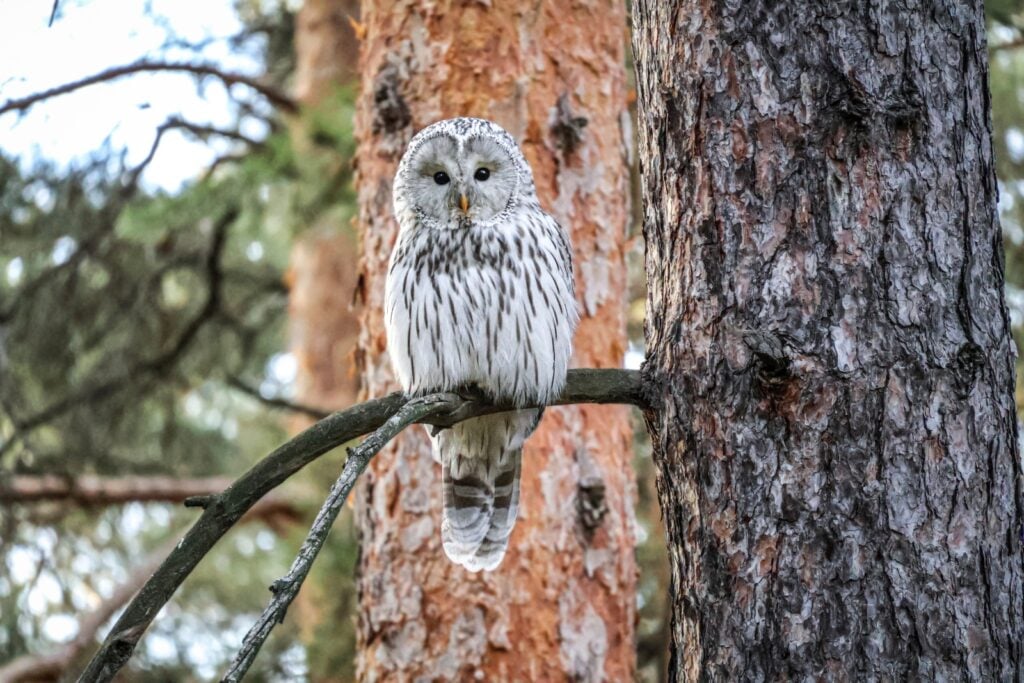
- Scientific Name: Strix uralensis
- Habitat: Forests across areas of Europe and Asia
- Size: 3.6 to 4.4 foot wingspan
- Diet: Small mammals, birds, amphibians, reptiles, insects
Ural owls are stunning birds that have a pattern of white and dark brown feathers. Their dark eyes offer excellent binocular vision that allows them to easily spot prey even at night. While they’re nocturnal, they may become active when it’s light out during warm months with long days. While they primarily hunt rodents and other small mammals, they’re opportunistic hunters that will take down any available prey. They wait on a perch until they see prey to swoop at.
34. Urial
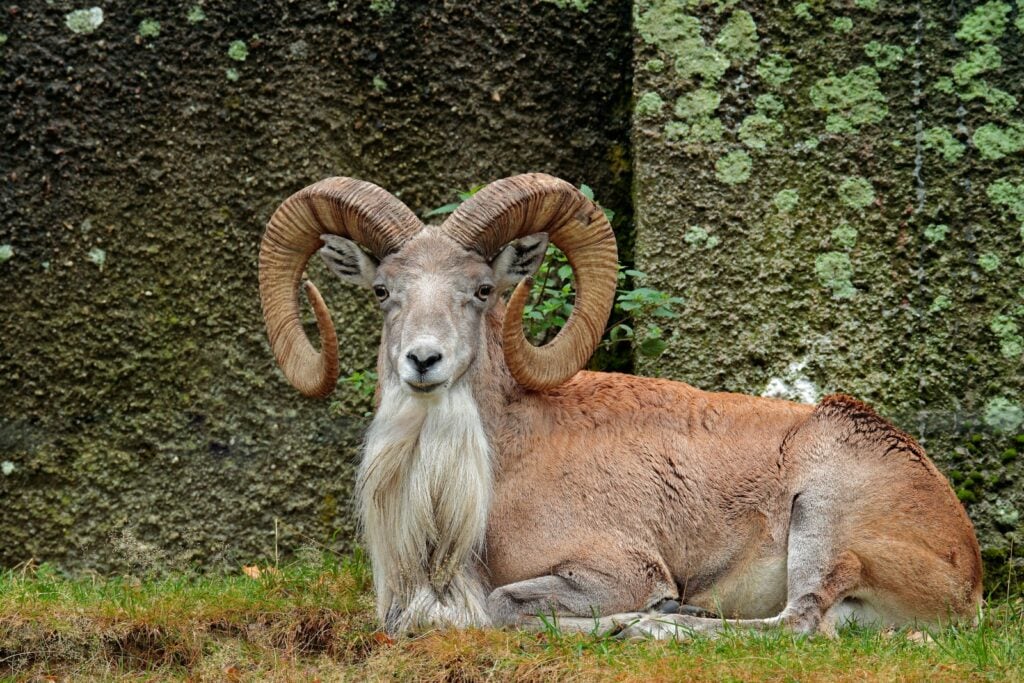
- Scientific Name: Ovis vignei
- Habitat: Grassy areas of the Pamir Mountains, Hindu Kush, and Himalayas
- Size: 100 to 200 pounds
- Diet: Grasses, shrubs, grains
Both males and females of this wild sheep species have curled horns, but the males have much larger horns. They use these horns to fight for dominance, which can help them determine where each urial ranks in a herd. So, the bigger the horns, the more dominant a urial usually is. Herds can include over 100 individuals, but females and their young typically have separate herds from males.
35. Ursula’s Sunbird
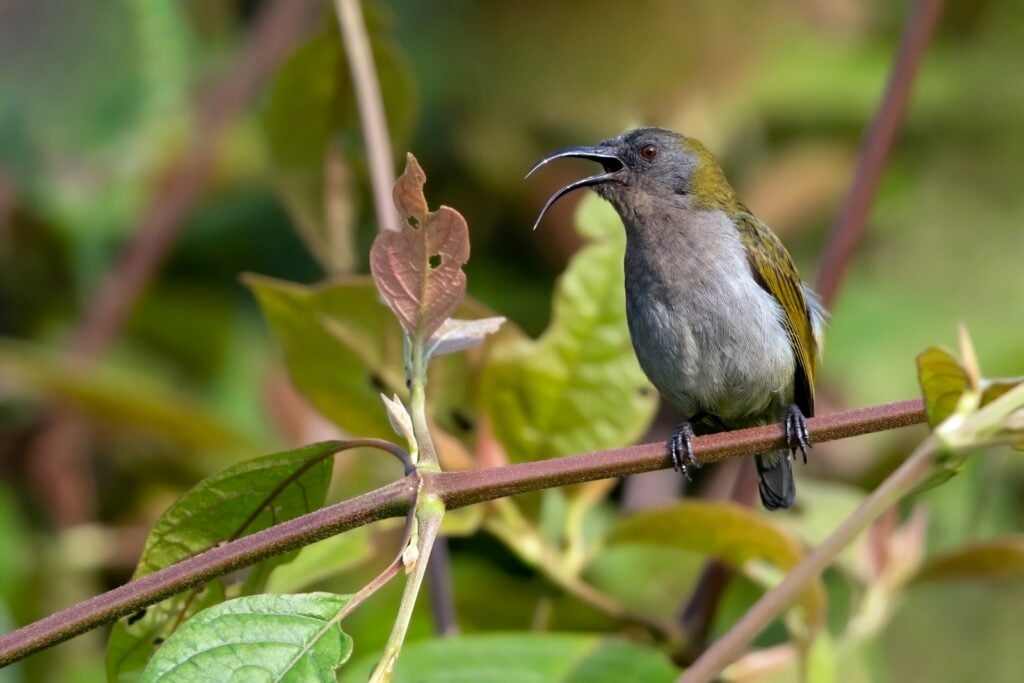
- Scientific Name: Cinnyris ursulae
- Habitat: Subtropical and tropical montane forests of Cameroon
- Size: 3.5 to 4 inches
- Diet: Nectar, seeds, insects
While most sunbird species display vibrant colors, Ursula’s sunbird is a more neutral species. These birds have gray feathers around their faces and bellies with green feathers on their backs, helping them blend into forest settings. Their bills have a distinct curved shape, which makes it easy for them to collect nectar from flowers. Their calls include patterns of sharp, high-pitched notes.
36. Urutu Snake
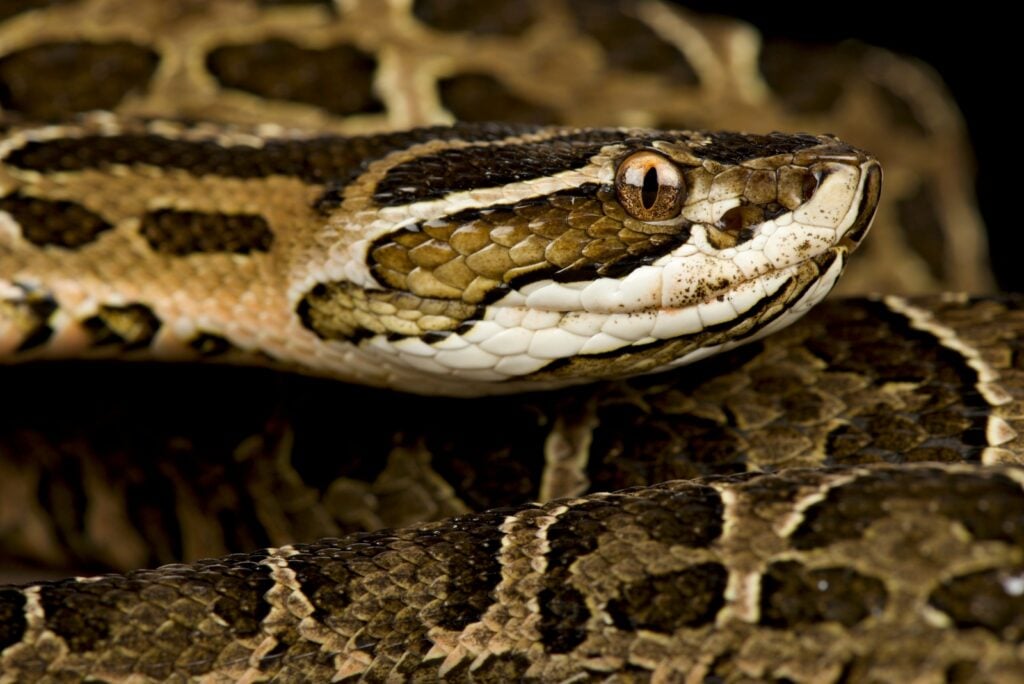
- Scientific Name: Bothrops alternatus
- Habitat: Forests near wetlands of eastern South America
- Size: 3 to 6.5 feet long
- Diet: Mammals, frogs, lizards, other snakes, birds
Urutu snakes have powerful venom that immediately causes tissue damage, which can also lead to blood clotting, and in extreme cases, death. Luckily, bites from them are rare since they live in moist areas away from humans. If a bite occurs, amputations are common due to the rapid tissue death. These snakes detect prey using heat-sensing pits in their heads, and they won’t hesitate to defend themselves if they perceive a creature as a threat.
37. Ussuri Brown Bear

- Scientific Name: Ursus arctos lasiotus
- Habitat: Forests and mountainous regions of eastern Asia
- Size: 440 to 1,300 pounds
- Diet: Nuts, berries, plant matter, fish, small mammals
Surprisingly, Ussuri brown bears are mostly vegetarian despite being able to kill a wide range of prey. Their diet varies based on what’s available, so if nuts and berries are scarce, they’re more likely to hunt fish and small mammals. They excavate burrows as winter dens. Females give birth to cubs in their winter dens, and those cubs stay with the mother for two to three years before parting ways. Mother bears don’t get pregnant again until those cubs leave.
38. Ussuri Dhole
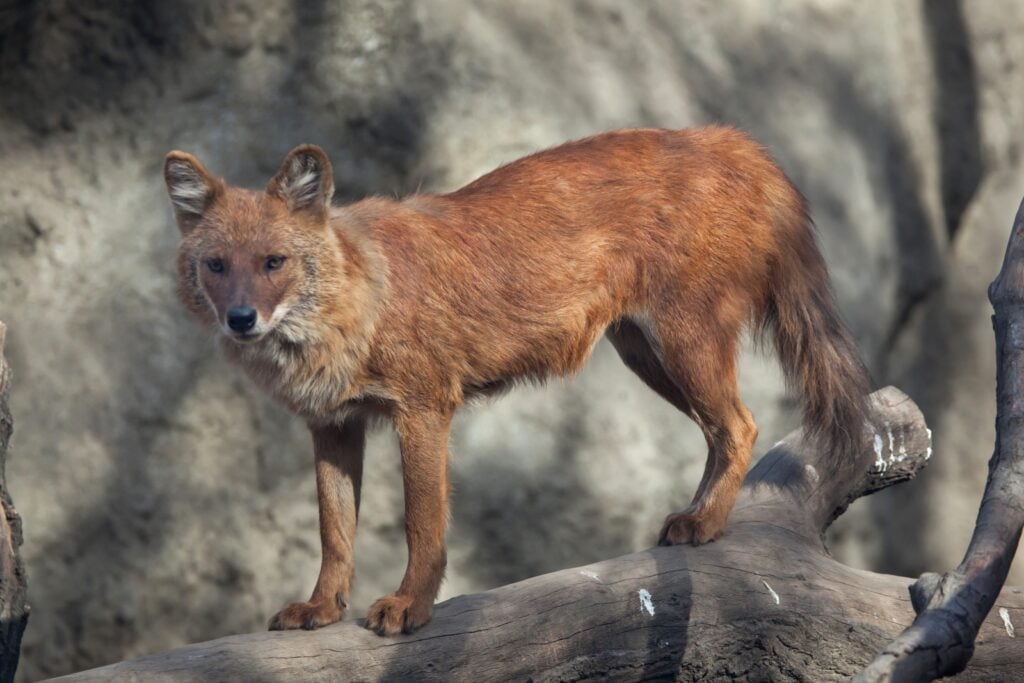
- Scientific Name: Cuon alpinus alpinus
- Habitat: Forests, grasslands, and plains of central and southern Asia
- Size: 22 to 46 pounds
- Diet: Mammals, fruit, vegetable matter
Ussuri dholes hunt a wide range of mammals, including everything from small rats to deer and boar. They hunt in packs to take down prey that’s larger than they are. While they often live in large clans, those clans break up into small groups of three to five when hunting. They’re much less territorial than wolves, and they don’t seem to participate in dominance displays among their packs. They build dens under dense scrub that are connected by tunnels.
39. Uta Hick’s Bearded Saki
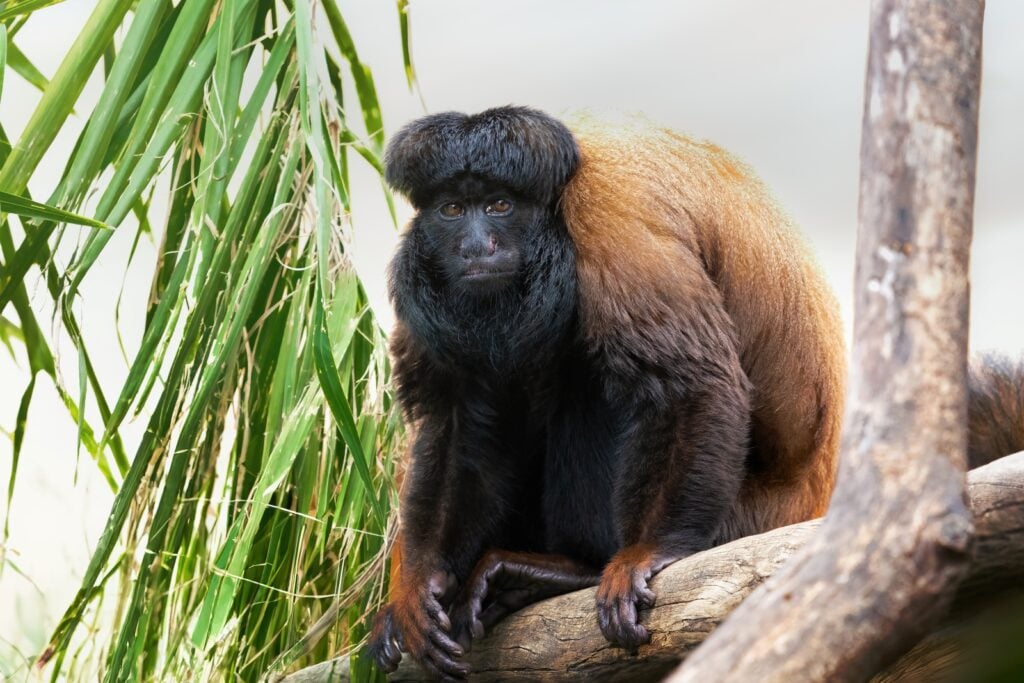
- Scientific Name: Chiropotes utahicki
- Habitat: Rainforests of Brazil
- Size: 5 to 9 pounds
- Diet: Fruits, nuts, seeds
These primates are named after Uta Hick, a German primatologist who cared for this species. The Uta Hick’s bearded saki was once considered a subspecies of the black bearded saki, but this species has unique pale brown coloring on its back. They’re peaceful and social, living in groups of about 20 individuals. They often play, groom, and sleep with others in their group. To drink, they scoop up water in their hands and drink out of it like a cup.
40. Utah Mountain Kingsnake
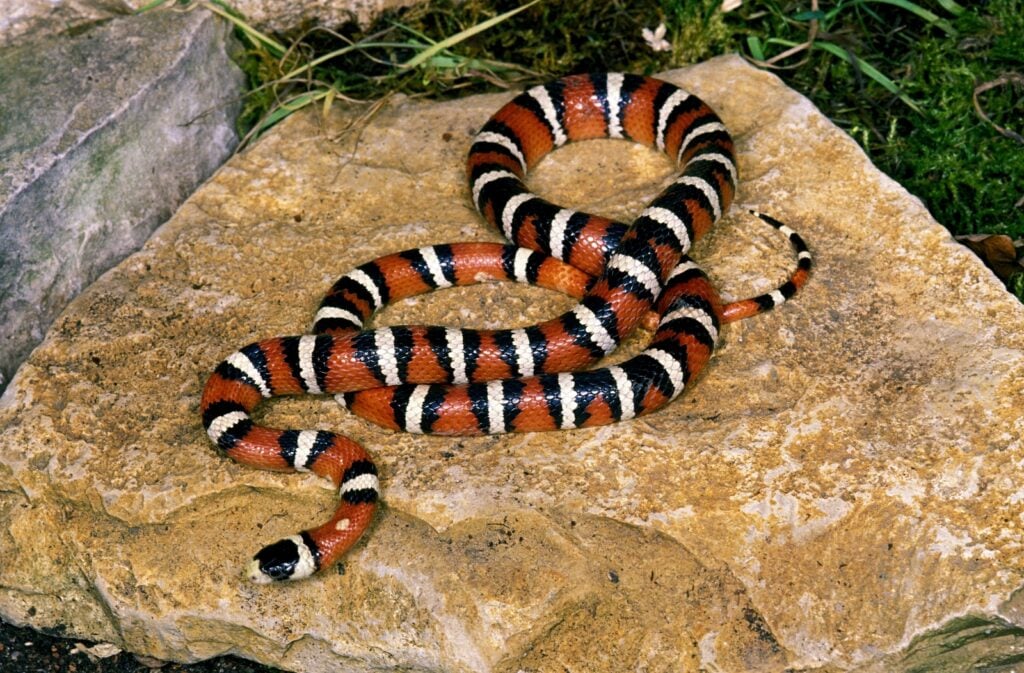
- Scientific Name: Lampropeltis pyromelana
- Habitat: Rocky, mountainous regions of Utah, Nevada, and Arizona
- Size: 2 to 3 feet long
- Diet: Lizards, small snakes, small mammals
While the bright colors of this snake might make people think they’re dangerous, Utah mountain kingsnakes are nonvenomous. They’re resistant to the venom of some snakes like pit vipers, so they sometimes hunt other snake species. These snakes are most active from spring to fall, but they brumate (which is similar to hibernating) in the winter to conserve energy and regulate their body temperature.
41. Utah Prairie Dog
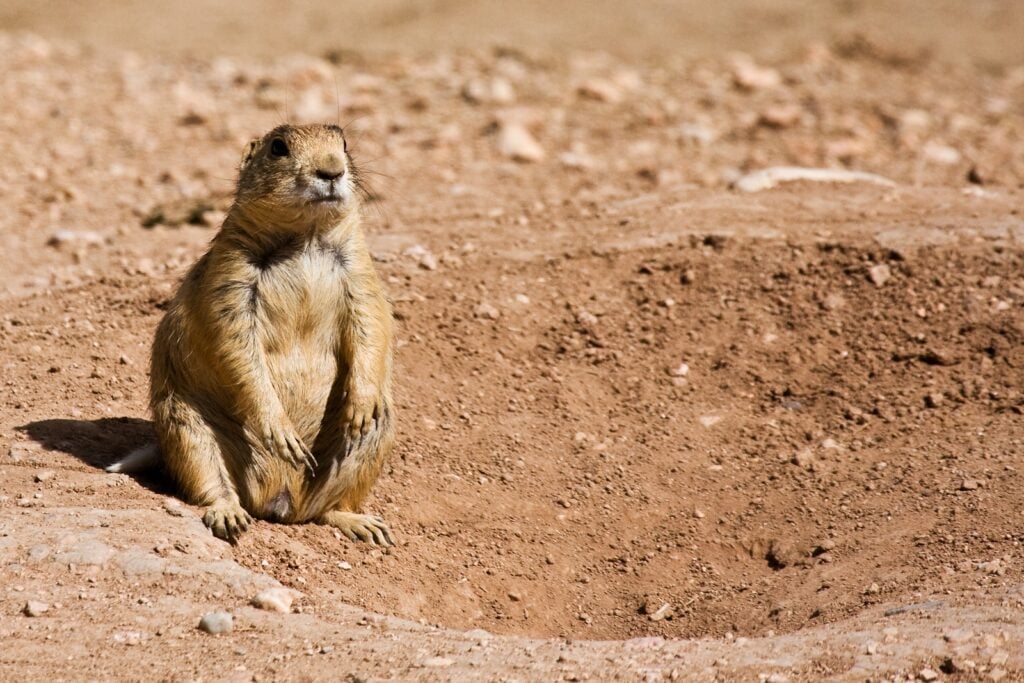
- Scientific Name: Cynomys parvidens
- Habitat: Prairies and mountain meadows of southwestern Utah
- Size: 12 to 16 inches
- Diet: Grasses, seeds, flowers, leaves, insects
Utah prairie dogs live in colonies known as “towns.” The towns usually have one dominant male, several females, and any young born in the last two years. These groups share burrows that can reach 6 feet deep and 15 feet long. The burrows not only provide a place to rest, but they’re also safe areas to retreat to when predators approach. There are several entrance and exit points in the burrows so the prairie dogs can easily navigate them.
42. Utila Spiny-Tailed Iguana
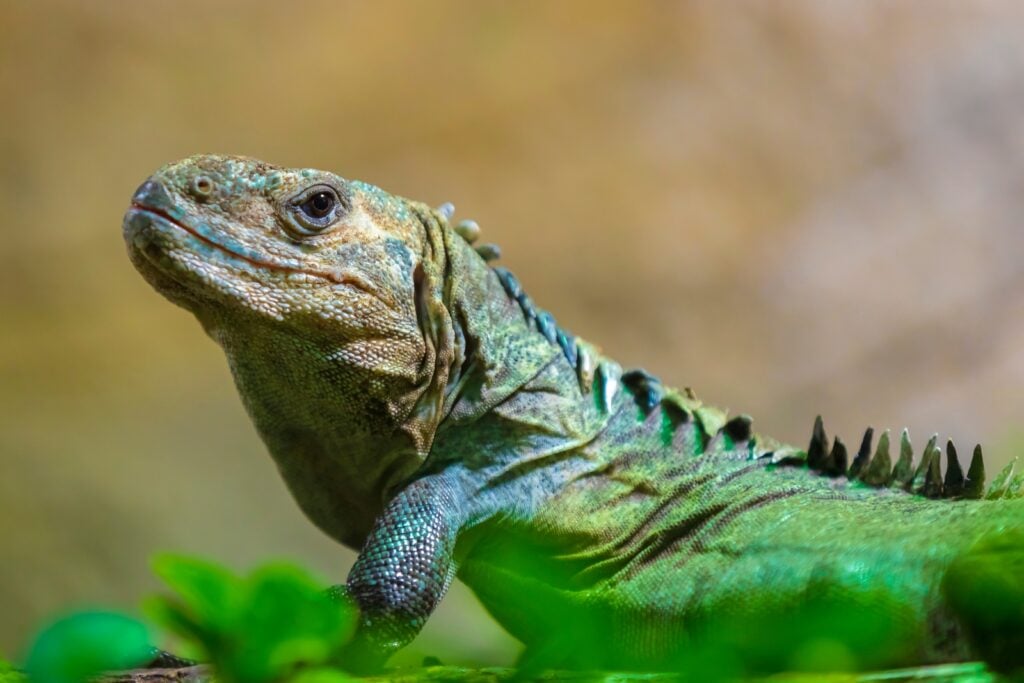
- Scientific Name: Ctenosaura bakeri
- Habitat: Mangrove forests and coastal vegetated areas on the island of Utila, Honduras
- Size: Up to three feet long
- Diet: Leaves, flowers, other plant matter, eggs, small animals
Utila spiny-tailed iguanas are critically endangered, with only about 5,000 individuals left. Since they primarily live in swampy forests, they’ve earned the nickname “Swampers.” They hide in hollow mangrove trees and come out to bask in the sun in the morning. Sadly, habitat loss is the primary reason for their decline, largely due to the significant increase in tourist development. Invasive predators, such as raccoons, may also play a role.
More Animals (A-Z)
There are a lot of incredible animals that start with the letter U, but it’s actually one of the letters with the fewest species. There are tons of animal species to explore under every letter of the alphabet, and some letters have so many species that it’s difficult to name them all. So, curious animal lovers should keep exploring to discover how much more they can learn about the animal kingdom.
A, B, C, D, E, F, G, H, I, J, K, L, M, N, O, P, Q, R, S, T, U, V, W, X, Y, Z








